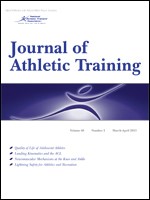Context: The King-Devick (KD) test is a screening tool designed to assess cognitive visual impairments, namely saccadic rhythm, post-concussion. Test-retest reliability of the KD in a healthy adolescent population has not yet been established.
Objective: To investigate the overall test-retest reliability of the KD among a sample of healthy adolescents. Additionally, we sought to determine if sex and age influenced reliability.
Design: Cross-sectional study.
Setting: Secondary school.
Patients or Other Participants: Sixty-eight healthy adolescents, 41 boys (age =15.4 ± 1.9 years) and 27 girls (age = 15.4 ± 1.9 years).
Main Outcome Measure(s): Participants completed the KD (version 1) at 3 testing sessions (days 1, 30, and 45) following standard instructions. We recorded total time to complete the reading of 3 cards for each participant during each testing session. Two-way random-effects intraclass correlation coefficients (ICCs) using single measurements repeated over time and repeatability coefficients were calculated. Linear mixed models were used to determine whether differences existed at each testing time and to examine whether changes that took place among visits were different by sex or age.
Results: Adolescents who completed the KD demonstrated acceptable reliability (ICC = 0.81; 95% confidence interval = 0.73, 0.87); however, the repeatability coefficient was large (±8.76 seconds). The sample demonstrated improvements between visits 1 and 2 (mean ± standard error = 4.3 ± 0.5 seconds, P < 0.001) and between visits 2 and 3 (2.4 ± 0.5 seconds, P < 0.001) for a total improvement of 6.7 seconds over 3 tests. No significant visit-by-sex or visit-by-age interactions were observed.
Conclusions: Despite the ICC being clinically acceptable, providers using the KD test for serial assessment of concussion in adolescents should be cautious in interpreting the results due to a large learning effect. Incorporating multiple measures can ensure accurate detection of sport concussion.
Summary Points:
- In our entire sample, the ICC revealed good test-retest reliability from day 1 to day 45.
- Time to complete the K-D Test decreased at each visit (Day 1, 30, and 45).
- No difference in time to complete the test was demonstrated between sexes.
- At baseline, adolescents 15 years and younger took longer to complete the test than adolescents 16 and older.
- Evaluating changes or deficits in oculomotor function should be considered as part of the concussion-assessment process.
- The K-D Test is designed to screen changes in oculomotor function and has been introduced as a potential addition to the tests currently available to determine if an athlete has sustained a concussion.
- A key advantage of the K-D Test is its ease of delivery, both in the collection of baseline data and as a rapid assessment tool post-injury. With practice, health care providers and laypersons (e.g. parents and coaches) can learn how to deliver the test.
- Established learning effects demonstrated by improvements in time to complete the K-D Test over time in a healthy sample of participants (adolescents and adults) have been reported by other investigators. Our findings in a healthy adolescent population are consistent with these results.

